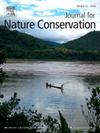Assessment of the pattern of fuelwood consumption and impacts on woody plant species in the Bale Mountains National Park, southeastern Ethiopia
IF 2.2
3区 环境科学与生态学
Q2 BIODIVERSITY CONSERVATION
引用次数: 0
Abstract
National parks have been principally used for conservation besides their high ecological and economic values. The use and collection of fuelwoods, along with their consumption patterns for energy sources, could potentially impact the biodiversity of the parks. The study, thus aimed to investigate patterns of fuelwood collection and consumption and its impacts on plant biodiversity in Bale Mountains National Park (BMNP). A total of 32 plots (30 m x 30 m) were established along five-line transects to collect the composition of woody species and their DBH. The socio-economic data were collected through a questionnaire from 345 respondents. A total of 7 tree and shrub species were identified in the forest sites of the park. The most abundant and most preferred tree species was Juniperus procera, followed by Hagenia abyssinica. The average annual consumption of household fuelwood was estimated to be 6.14 tons. The household fuelwood consumption was found to be significantly increased with large household size, and livestock size. Similarly, it also increased with elevation and distance from the town. The majority of the wood sellers were females and the main fuelwood source in the study area was the Boditti and Addelle forest sites. The result of the study revealed that the trees in the forest sites of the park showed J-shaped population structures. Hence, unless an alternative source of energy is available and the community understands the long-lasting socio-ecological impact of over-exploitation of native trees and shrubs from the BMNP, disastrous effects will be inevitable.
评估埃塞俄比亚东南部巴莱山国家公园的薪材消耗模式及其对木本植物物种的影响
国家公园除了具有很高的生态和经济价值外,还主要用于保护。薪材的使用和采集,以及其作为能源的消费模式,可能会对公园的生物多样性产生潜在影响。因此,本研究旨在调查薪材采集和消耗模式及其对巴勒山国家公园(BMNP)植物生物多样性的影响。研究人员沿五线横断面共设置了 32 个地块(30 米 x 30 米),以收集木质树种的构成及其 DBH。社会经济数据是通过向 345 名受访者发放调查问卷收集的。在公园的森林地点共发现了 7 种乔木和灌木。数量最多、最受欢迎的树种是杜松(Juniperus procera),其次是阿比西尼亚树(Hagenia abyssinica)。据估计,家庭薪材年平均消耗量为 6.14 吨。家庭薪材消耗量随家庭人口和牲畜数量的增加而显著增加。同样,海拔高度和与城镇的距离也会增加家庭薪材消耗量。大多数卖柴人是女性,研究地区的主要薪材来源是 Boditti 和 Addelle 林区。研究结果表明,公园森林地点的树木呈现出 "J "形种群结构。因此,除非有替代能源,而且社区了解过度开采巴马国家公园本地树木和灌木对社会生态造成的长期影响,否则灾难性后果将不可避免。
本文章由计算机程序翻译,如有差异,请以英文原文为准。
求助全文
约1分钟内获得全文
求助全文
来源期刊

Journal for Nature Conservation
环境科学-生态学
CiteScore
3.70
自引率
5.00%
发文量
151
审稿时长
7.9 weeks
期刊介绍:
The Journal for Nature Conservation addresses concepts, methods and techniques for nature conservation. This international and interdisciplinary journal encourages collaboration between scientists and practitioners, including the integration of biodiversity issues with social and economic concepts. Therefore, conceptual, technical and methodological papers, as well as reviews, research papers, and short communications are welcomed from a wide range of disciplines, including theoretical ecology, landscape ecology, restoration ecology, ecological modelling, and others, provided that there is a clear connection and immediate relevance to nature conservation.
Manuscripts without any immediate conservation context, such as inventories, distribution modelling, genetic studies, animal behaviour, plant physiology, will not be considered for this journal; though such data may be useful for conservationists and managers in the future, this is outside of the current scope of the journal.
 求助内容:
求助内容: 应助结果提醒方式:
应助结果提醒方式:


